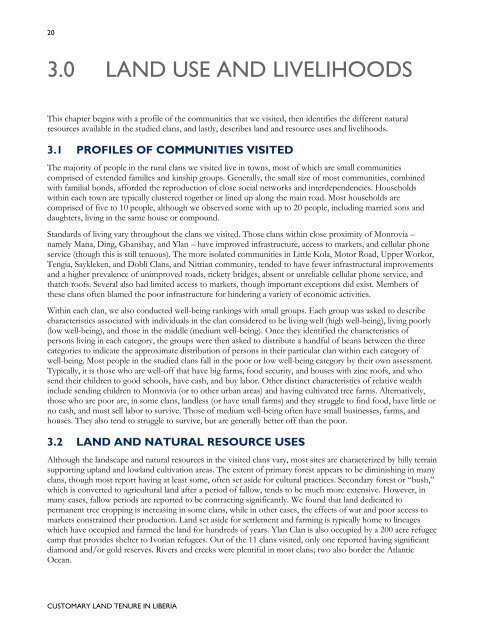Customary Land Tenure in Liberia - Land Tenure and Property ...
Customary Land Tenure in Liberia - Land Tenure and Property ...
Customary Land Tenure in Liberia - Land Tenure and Property ...
You also want an ePaper? Increase the reach of your titles
YUMPU automatically turns print PDFs into web optimized ePapers that Google loves.
20<br />
3.0 LAND USE AND LIVELIHOODS<br />
This chapter beg<strong>in</strong>s with a profile of the communities that we visited, then identifies the different natural<br />
resources available <strong>in</strong> the studied clans, <strong>and</strong> lastly, describes l<strong>and</strong> <strong>and</strong> resource uses <strong>and</strong> livelihoods.<br />
3.1 PROFILES OF COMMUNITIES VISITED<br />
The majority of people <strong>in</strong> the rural clans we visited live <strong>in</strong> towns, most of which are small communities<br />
comprised of extended families <strong>and</strong> k<strong>in</strong>ship groups. Generally, the small size of most communities, comb<strong>in</strong>ed<br />
with familial bonds, afforded the reproduction of close social networks <strong>and</strong> <strong>in</strong>terdependencies. Households<br />
with<strong>in</strong> each town are typically clustered together or l<strong>in</strong>ed up along the ma<strong>in</strong> road. Most households are<br />
comprised of five to 10 people, although we observed some with up to 20 people, <strong>in</strong>clud<strong>in</strong>g married sons <strong>and</strong><br />
daughters, liv<strong>in</strong>g <strong>in</strong> the same house or compound.<br />
St<strong>and</strong>ards of liv<strong>in</strong>g vary throughout the clans we visited. Those clans with<strong>in</strong> close proximity of Monrovia –<br />
namely Mana, D<strong>in</strong>g, Gbanshay, <strong>and</strong> Ylan – have improved <strong>in</strong>frastructure, access to markets, <strong>and</strong> cellular phone<br />
service (though this is still tenuous). The more isolated communities <strong>in</strong> Little Kola, Motor Road, Upper Workor,<br />
Tengia, Saykleken, <strong>and</strong> Dobli Clans, <strong>and</strong> Nitrian community, tended to have fewer <strong>in</strong>frastructural improvements<br />
<strong>and</strong> a higher prevalence of unimproved roads, rickety bridges, absent or unreliable cellular phone service, <strong>and</strong><br />
thatch roofs. Several also had limited access to markets, though important exceptions did exist. Members of<br />
these clans often blamed the poor <strong>in</strong>frastructure for h<strong>in</strong>der<strong>in</strong>g a variety of economic activities.<br />
With<strong>in</strong> each clan, we also conducted well-be<strong>in</strong>g rank<strong>in</strong>gs with small groups. Each group was asked to describe<br />
characteristics associated with <strong>in</strong>dividuals <strong>in</strong> the clan considered to be liv<strong>in</strong>g well (high well-be<strong>in</strong>g), liv<strong>in</strong>g poorly<br />
(low well-be<strong>in</strong>g), <strong>and</strong> those <strong>in</strong> the middle (medium well-be<strong>in</strong>g). Once they identified the characteristics of<br />
persons liv<strong>in</strong>g <strong>in</strong> each category, the groups were then asked to distribute a h<strong>and</strong>ful of beans between the three<br />
categories to <strong>in</strong>dicate the approximate distribution of persons <strong>in</strong> their particular clan with<strong>in</strong> each category of<br />
well-be<strong>in</strong>g. Most people <strong>in</strong> the studied clans fall <strong>in</strong> the poor or low well-be<strong>in</strong>g category by their own assessment.<br />
Typically, it is those who are well-off that have big farms, food security, <strong>and</strong> houses with z<strong>in</strong>c roofs, <strong>and</strong> who<br />
send their children to good schools, have cash, <strong>and</strong> buy labor. Other dist<strong>in</strong>ct characteristics of relative wealth<br />
<strong>in</strong>clude send<strong>in</strong>g children to Monrovia (or to other urban areas) <strong>and</strong> hav<strong>in</strong>g cultivated tree farms. Alternatively,<br />
those who are poor are, <strong>in</strong> some clans, l<strong>and</strong>less (or have small farms) <strong>and</strong> they struggle to f<strong>in</strong>d food, have little or<br />
no cash, <strong>and</strong> must sell labor to survive. Those of medium well-be<strong>in</strong>g often have small bus<strong>in</strong>esses, farms, <strong>and</strong><br />
houses. They also tend to struggle to survive, but are generally better off than the poor.<br />
3.2 LAND AND NATURAL RESOURCE USES<br />
Although the l<strong>and</strong>scape <strong>and</strong> natural resources <strong>in</strong> the visited clans vary, most sites are characterized by hilly terra<strong>in</strong><br />
support<strong>in</strong>g upl<strong>and</strong> <strong>and</strong> lowl<strong>and</strong> cultivation areas. The extent of primary forest appears to be dim<strong>in</strong>ish<strong>in</strong>g <strong>in</strong> many<br />
clans, though most report hav<strong>in</strong>g at least some, often set aside for cultural practices. Secondary forest or “bush,”<br />
which is converted to agricultural l<strong>and</strong> after a period of fallow, tends to be much more extensive. However, <strong>in</strong><br />
many cases, fallow periods are reported to be contract<strong>in</strong>g significantly. We found that l<strong>and</strong> dedicated to<br />
permanent tree cropp<strong>in</strong>g is <strong>in</strong>creas<strong>in</strong>g <strong>in</strong> some clans, while <strong>in</strong> other cases, the effects of war <strong>and</strong> poor access to<br />
markets constra<strong>in</strong>ed their production. <strong>L<strong>and</strong></strong> set aside for settlement <strong>and</strong> farm<strong>in</strong>g is typically home to l<strong>in</strong>eages<br />
which have occupied <strong>and</strong> farmed the l<strong>and</strong> for hundreds of years. Ylan Clan is also occupied by a 200 acre refugee<br />
camp that provides shelter to Ivorian refugees. Out of the 11 clans visited, only one reported hav<strong>in</strong>g significant<br />
diamond <strong>and</strong>/or gold reserves. Rivers <strong>and</strong> creeks were plentiful <strong>in</strong> most clans; two also border the Atlantic<br />
Ocean.<br />
CUSTOMARY LAND TENURE IN LIBERIA

















